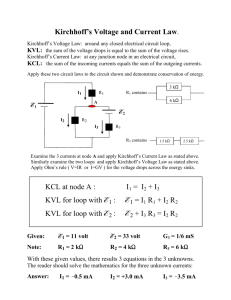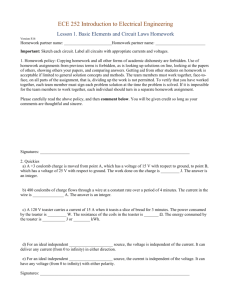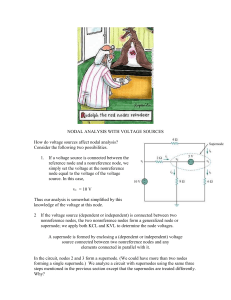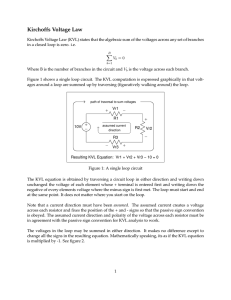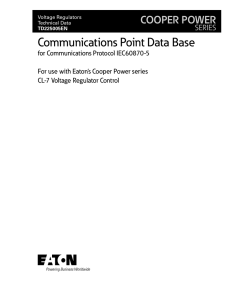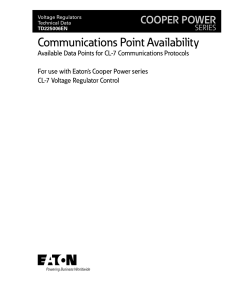Homework #5 - SEAS - George Washington University
advertisement
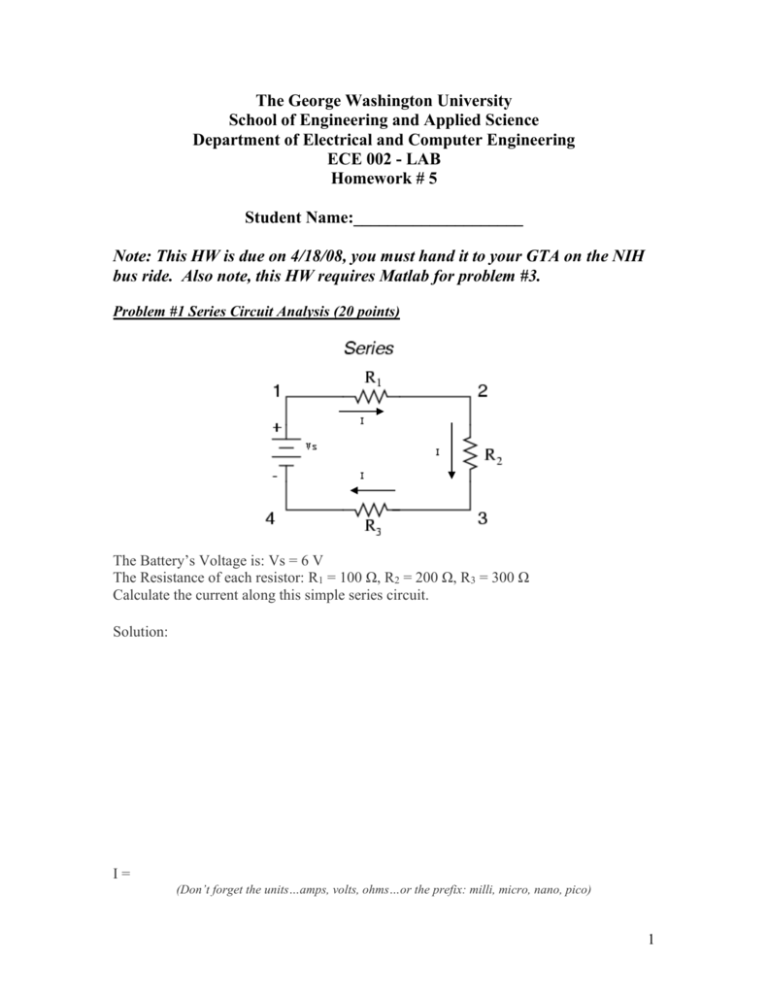
The George Washington University School of Engineering and Applied Science Department of Electrical and Computer Engineering ECE 002 - LAB Homework # 5 Student Name:____________________ Note: This HW is due on 4/18/08, you must hand it to your GTA on the NIH bus ride. Also note, this HW requires Matlab for problem #3. Problem #1 Series Circuit Analysis (20 points) The Battery’s Voltage is: Vs = 6 V The Resistance of each resistor: R1 = 100 Ω, R2 = 200 Ω, R3 = 300 Ω Calculate the current along this simple series circuit. Solution: I= (Don’t forget the units…amps, volts, ohms…or the prefix: milli, micro, nano, pico) 1 Problem #2 Parallel Circuit Analysis(20 points) I1 I2 The Resistance of each resistor: R1 = 200 Ω, R2 = 300 Ω, The Current across each resistor: I1 = 60 mA , I2 = 40 mA Calculate the voltage across each resistor VR1 and VR2. Calculate the battery’s voltage: Vs? Solution: VR1= VR2= VS = (Don’t forget the units…amps, volts, ohms…or the prefix: milli, micro, nano, pico) 2 Problem #3 Mesh Current Analysis – Why we need Matlab in Circuits (30 points) Taking a look at this circuit, it is called unbalanced Wheatstone bridge. It is a famous and very practical circuit configuration used in many devices today: Figure 1 Battery: Vs = 24 V Resistors: R1 = 150Ω, R2 = 50 Ω, R3 = 100 Ω, R4 = 300 Ω and R5 = 250 Ω This type of circuit is irreducible by normal series-parallel analysis. You can see that nothing is in parallel nor in series with anything else. Try it out if you don’t believe! One way to find the current in this circuit, is to use something called the “Mesh Current Method”, which we full explain below. STEP 1 The first step in the ‘Mesh Current’ method is to draw something called the “mesh currents” to account for all the possible paths current can ‘flow’ in the circuit. Look at figure 2, to see how we drew the ‘mesh currents’. The directions of these mesh currents, are arbitrary, in the end, if we were wrong in the direction: I1, I2, or I3 will have a negative sign telling us to reverse the arrow’s direction. Why are there 3 currents? Two mesh currents (I1 & I2) are not enough in this circuit, because neither I1 nor I2 goes through the battery. So, we must add a third mesh current, I3. Here, we have chosen I3 to loop from the bottom side of the battery, through R4, through R1, and back to the top side of the battery. This is not the only path we could have chosen for I3, but it seems the simplest. 3 STEP 2 Now, we must label the resistor voltage drop polarities, following the directions of the mesh currents' we previously assumed. By polarity, look at how mesh current I1 flows through R2. The ‘terminal’ of the resistor that I1 enters into we label the ‘positive’ polarity, and the ‘terminal’ of the resistor that I1 exits is labeled the ‘negative’ polarity. Notice something very important here: at resistor R4, the polarities for the respective mesh currents do not agree. This is because those mesh currents (I2 and I3) are going through R4 in different directions. So in reality the current flowing through R4 is the difference of I2 and I3. This is why we call them ‘mesh currents’ they are not the ACTUAL currents flowing through the resistors, but the sums and differences of them will be in the end. Figure 2 STEP 3 Generating a KVL equation for each loop. Kirchhoff's Voltage Law (KVL): The sum of the voltage drops around any closed circuit must be zero. Remember, the word ‘circuit’ means loop, like the word ‘circle.’ (You will get to know KVL very well in ECE11.) FOR THE TOP LOOP (where current I1 is located in figure 2): Starting from the top node and tracing in a clockwise direction: The voltage drop across R2: VR2 = R2 I1 The voltage drop across R3: VR3 = R3 (I1 + I2) **** see note 1 below 4 The voltage drop across R1: VR1 = R1 (I1 + I3) The sum of the voltage drops around this loop = VR1+VR2 + VR3 Therefore, from KVL: VR1+VR2 + VR3 = 0 => Substituting the expressions for VR1,VR2 and VR3 into the above equation: R2 I1 + R3 (I1 + I2) + R1(I1 + I3) = 0 => Substituting the values of R1, R2 and R3 into the above equation: 50 I1 + 100(I1+I2) + 150(I1+I3) = 0 => Simplifying the above equation: 300 I1 + 100 I2 +150 I3 = 0 (1) ****NOTE 1: In the equation above: VR3 = R3 (I1 + I2), why did we ‘add’ I1 and I2? Why not take the difference? Because mesh current I1 and mesh current I2 flow in the ‘same’ direction through resistor R3, so it makes sense to add them! If they were in opposite directions, we would subtract them. How do we know which one to subtract? It depends on what loop we’re in! If we’re in I1’s loop, we’d subtract I2 (if I2 were flowing the other way) FOR THE BOTTOM LOOP (where I2 is located in figure 2): The voltage drop across R3: VR3 = R3 (I1 + I2) The voltage drop across R4: VR4 = R4 (I2 – I3) The voltage drop across R5: VR5 = R5 I2 The sum of the voltage drops around this loop = VR3 + VR4 + VR5 Therefore, from KVL (and simplifying a bit): VR3 + VR4 + VR5= 0 => R3 (I1 + I2) + R4 (I2 – I3) + R5 I2 = 0 => 100 (I1 + I2) + 300 (I2 – I3) + 250 I2 = 0 => 100 I1 + 650 I2 – 300 I3 = 0 (2) FOR THE LEFT LOOP (Containing the battery & mesh current I3): The voltage drop across the battery: Vs = 24 V The voltage drop across R1: VR1 = R1 (I1 + I3) The voltage drop across R4: VR4 ’= -VR4 = - R4 (I2 – I3) ****see note 2 below 5 The sum of the voltage drops around this loop = - Vs + VR1 + VR4’ Therefore, from KVL: - Vs + VR1 + VR5 = 0 => - Vs + R1 (I1 + I3) - R4 (I2 – I3)= 0 => -24 + 150 (I1 + I3) - 300 (I2 – I3) = 0 => 150 I1 - 300 I2 + 450 I3 = 24 (3) ****Note 2: why is R4 negative? Remember the polarity problem with R4’s mesh currents? This corrects that little hick-up! STEP 4 Combining equation (1) (2) and (3), we get a system of three linear equations: 300 I1 + 100 I2 + 150 I3 = 0 (1) 100 I1 + 650 I2 – 300 I3 = 0 (2) 150 I1 - 300 I2 + 450 I3 = 24 (3) 6 STEP 5 –This step is your job! Even if you didn’t understand any of the above, that’s ok, although this is good easy time to understand before you get to ECE 11!! What this boils down to is a simple matrix problem. You will have many of these in ECE 11, the point of this example is to show you why you would want to use Matlab in ECE 11. The only thing you must do to solve this problem is solve the matrix below in matlab: Putting the above system of linear equations into the matrix form: 150 I1 0 300 100 100 650 300 I2 0 150 300 450 I3 24 Letting: 150 300 100 Matrix A = 100 650 300 ; Column vector I = 150 300 450 I1 I 2 ; Column vector V = I3 0 0 . 24 Please solve this matrix equation for the unknown column vector I in Matlab: AI = V Paste your Matlab codes below or attach another paper: 7 _________________________ . Your result: I = __________________________ _________________________ So that I1 = ______________ I2 = ______________ I3 = ______________ (Do not forget write down the unit for the currents!) Bonus Question (10 points): Is the value of I1 negative or positive? If I1 is negative, what does this mean? Solution: 8 Problem #4 NIH Knowledge Test (30 points) Let’s warm up for the coming visit to the NIH! 1. What does the initial “NIH” stand for? When the NIH was founded? (5 points) 2. How is the NIH funded? (5 points) 3. What is the annual operating budget of the NIH? (5 points) 4. How many institutes and centers that make up the NIH? Name five of them. And which institute or center are you likely interested in most? Why? (5 points) 5. Does the NIH offer summer internships? What are the basic requirements for the application? What is the deadline for it? (5 points) Don’t forget to cite any sources you may have used. 9


